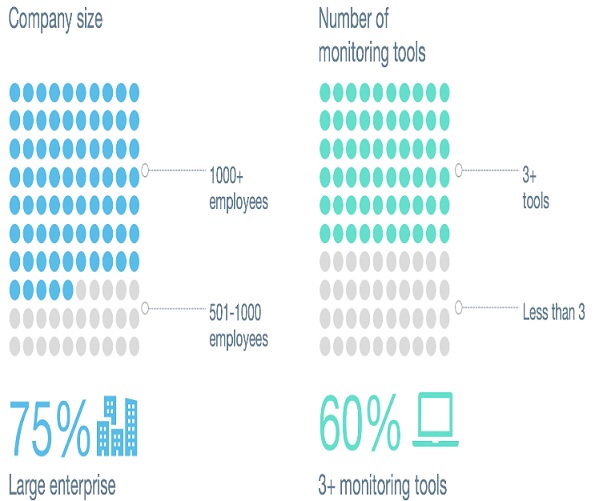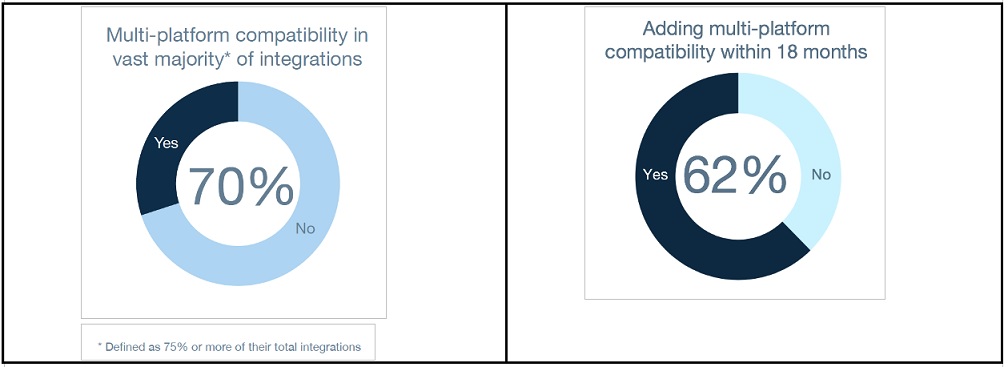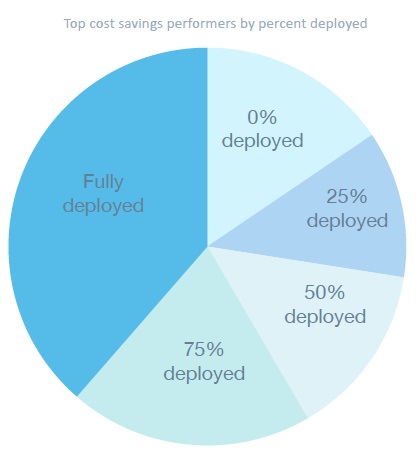In a June 2018 survey of over 400 IT professionals within the VMware User Group community, Blue Medora took a closer look at how various metric collection strategies and access to Dimensional Data impacts IT success. We started with one question: How important is your monitoring integration strategy?
We wanted to test if increased access, data depth and context provided by a Dimensional Data stream positively impacted IT outcomes. Dimensional Data refers to a real-time metric stream provided by a monitoring integration as a service (MIaaS). A Dimensional Data stream will include highly granular behavioral detail — beyond what a single endpoint API connection might include — as well as rich relational context.
75% of Companies Lack Critical Data to Manage IT System Health and Performance
The big takeaway — many organizations are running multiple monitoring tools in an effort to get the appropriate data depth and context they need across their entire IT stack. Sixty percent of respondents are already running three or more monitoring systems and 50% of them plan to consolidate monitoring tools in the next 18 months.
But despite that, two-thirds of IT ops teams still lack visibility into the external resource relationships and three-quarters lack access to component-level data resolution, resulting in more downtime than peers using monitoring integrations that provide this critical capability.
70% of respondents said most of their monitoring integrations were not compatible with more than one monitoring platform — a leading cause of metric silos in many organizations.
Dimensional Data adoption is still in its infancy, but demand is growing. Only 9% of organizations who participated in the survey currently have access to Dimensional Data across the majority of their integrations and are considered fully deployed. On average, 43% of organizations wish to increase Dimensional Data adoption within the next 18 months.

Figure 1: A breakdown of responses to the question "How many unique monitoring platforms do you have in use within your environment?"
Half of respondents indicated that they were trying to consolidate — perhaps in search of that elusive "single source of monitoring truth," but others had no near-term plans to decrease the number of monitoring tools. Some of the reasons they gave for sticking with all the tools they have included:
■ Different technologies monitored (infrastructure, cloud, etc.)
■ Different analytic or visualization capabilities
■ Different use cases (logs, performance, etc.)
■ Individual team preferences
70% of respondents said most of their monitoring integrations were not compatible with more than one monitoring platform, but demand is on the rise. Of that majority, 62% plan to make multi-platform metrics a reality in the near future.

Figure 2: Respondents’ current access to metrics across multiple platforms (without customization) is currently in the minority, but could move to the majority within the next two years.
The multi-platform adoption stats are particularly interesting when taken in context with the monitoring and tool consolidation stats in key finding one. For those not interested or planning to consolidate tools (again about half of the respondents in the survey) another path to eliminating metric silos has emerged--giving all monitoring platforms universal access to the same data set.
But back to that first question — How important is your monitoring integration strategy? We were surprised how much monitoring integrations impact respondents’ business. We’d heard it in conversations over the years but had never crunched the numbers. In four out of the five areas we examined, including productivity, utilization, downtime and cost savings the answer to our question was overwhelmingly yes.
Nearly 40% of the top performers in utilization and productivity gains had fully deployed Dimensional Data.

Figure 3: Of those reporting greater than $100k savings each year due to their monitoring integration strategy, 39% had fully deployed a dimensional data stream.
Of those who fully deployed Dimensional Data, one in five saw more than $1m a year in savings and one in two saw more than $100k in savings. Even we were blown away by the scale of savings.
It seems most monitoring research focuses on the efficacy of monitoring platforms or analytics engines but doesn’t spend a great deal of time looking at the data that goes into them. This research supported the idea that universal access to a Dimensional Data stream or other integration strategy that includes metric breadth, depth and context will likely have a positive context on key business measures like IT productivity, utilization, cost savings and downtime.
About the Survey: Blue Medora partnered with the VMware User Group (VMUG) to survey 410 of the group’s members about the current and near-future state of monitoring integration in their environment. All had IT responsibilities at organizations with over 500 employees. 76% of respondents held an admin or architect role within the IT organization.
The Latest
A vast majority (89%) of organizations have rapidly expanded their technology in the past few years and three quarters (76%) say it's brought with it increased "chaos" that they have to manage, according to Situation Report 2024: Managing Technology Chaos from Software AG ...
In 2024 the number one challenge facing IT teams is a lack of skilled workers, and many are turning to automation as an answer, according to IT Trends: 2024 Industry Report ...
Organizations are continuing to embrace multicloud environments and cloud-native architectures to enable rapid transformation and deliver secure innovation. However, despite the speed, scale, and agility enabled by these modern cloud ecosystems, organizations are struggling to manage the explosion of data they create, according to The state of observability 2024: Overcoming complexity through AI-driven analytics and automation strategies, a report from Dynatrace ...
Organizations recognize the value of observability, but only 10% of them are actually practicing full observability of their applications and infrastructure. This is among the key findings from the recently completed Logz.io 2024 Observability Pulse Survey and Report ...
Businesses must adopt a comprehensive Internet Performance Monitoring (IPM) strategy, says Enterprise Management Associates (EMA), a leading IT analyst research firm. This strategy is crucial to bridge the significant observability gap within today's complex IT infrastructures. The recommendation is particularly timely, given that 99% of enterprises are expanding their use of the Internet as a primary connectivity conduit while facing challenges due to the inefficiency of multiple, disjointed monitoring tools, according to Modern Enterprises Must Boost Observability with Internet Performance Monitoring, a new report from EMA and Catchpoint ...
Choosing the right approach is critical with cloud monitoring in hybrid environments. Otherwise, you may drive up costs with features you don’t need and risk diminishing the visibility of your on-premises IT ...
Consumers ranked the marketing strategies and missteps that most significantly impact brand trust, which 73% say is their biggest motivator to share first-party data, according to The Rules of the Marketing Game, a 2023 report from Pantheon ...
Digital experience monitoring is the practice of monitoring and analyzing the complete digital user journey of your applications, websites, APIs, and other digital services. It involves tracking the performance of your web application from the perspective of the end user, providing detailed insights on user experience, app performance, and customer satisfaction ...
Enterprises are experiencing a 13% year-over-year increase in customer-facing incidents, reflecting rising levels of complexity and risk as businesses drive operational transformation at scale, according to the 2024 State of Digital Operations study from PagerDuty ...





